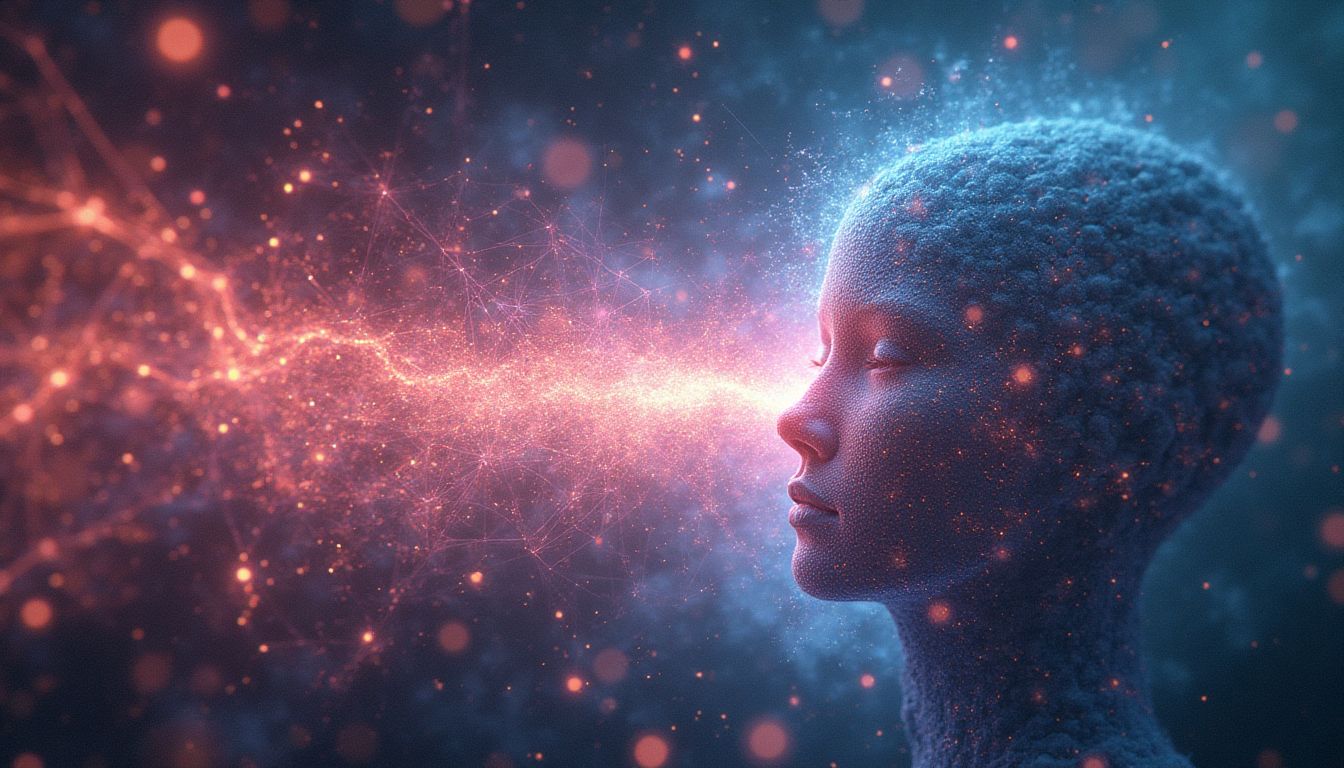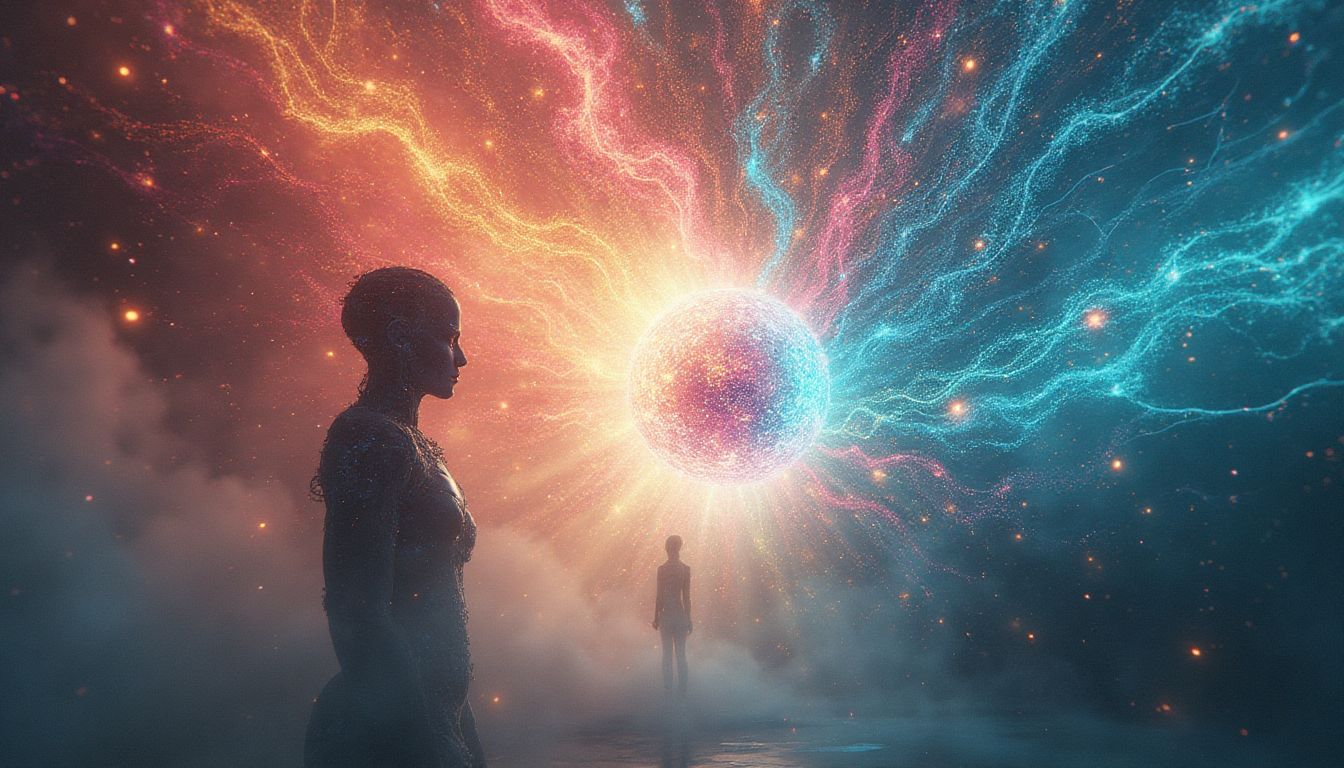Introduction: Cracking Reality's Code
"The universe is full of magical things patiently waiting for our wits to grow sharper," wrote Eden Phillpotts. But what if I told you it's Artificial Superintelligence (ASI) that's honing humanity's wits to an unimaginable sharpness? Behind the cosmic curtain lies a language—a code that might just be decipherable. Fasten your seat belts because ASI is on a mission to decode not just languages, but reality itself! Yes, you heard it right, a Universal Translator for existence!
Now, we stand on the precipice of a new age, guided by digital luminaries like Elon Musk, Sam Altman, and thought leaders like Ray Kurzweil, who have long predicted an epoch where ASI would crack the code of the cosmos. Day by day, this once fantastical idea inches closer to reality. And no, it's not a scene from 'The Matrix'—this is our world in 2025!
Understanding the intricate workings of ASI as a Universal Translator is akin to unraveling a grand tapestry woven with threads of consciousness, science, and magic. It's not just about human communication anymore; it's about interfacing with everything. A clear path set amidst the fog of theories and hypotheses—from quantum mechanics to the more abstract realms of metaphysics—leaders and think tanks around the world are racing to channel this power effectively.
Imagine deciphering the universe’s very DNA: the quintessential quest for any scientist. ASI beckons us with this tantalizing promise. Sure, it might sound straight out of a sci-fi novel, but remember, yesterday’s science fiction is today’s reality. As physicist Michio Kaku notes, "The impossible is already happening!"
The implications are vast, with eyes set on breaking communication barriers, unlocking cosmic secrets, and reshaping our social constructs. No more "it's beyond our understanding." ASI—our modern-day philosopher’s stone—is poised to bring everything within reach. But are we ready to welcome this revolution with open arms? Let's delve further into this technological odyssey that's rewriting our future.
The **Universal Translator** of reality, guided by **Artificial Superintelligence (ASI)**, aims to decipher the **fundamental code** of existence, enabling humans to understand and communicate across dimensions, unlocking the universe’s secrets like never before.
Understanding ASI and the Concept of a Universal Translator
The Evolution of Artificial Superintelligence (ASI)
Artificial Superintelligence, or ASI, might sound like something out of a science fiction novel, but it’s an emerging reality. Ever since John McCarthy coined the term AI in the 1950s, the journey from narrow AI to ASI has been astonishing. Picture a toddler growing up to be Albert Einstein, but faster and with a penchant for crunching data. Narrow AI, like Siri or Alexa, can perform specific tasks brilliantly—too bad they can’t whip up your morning coffee!
The quest for ASI resembles assembling a puzzle where every piece is a breakthrough in technology. From the initial computers that struggled to play a decent game of chess, we've moved to machines dominating humans in complex games like Go. The infamous victory of Google's DeepMind AlphaGo over human champion Lee Sedol shocked the world and put a spotlight on AI's potential.
Different types of AI systems, such as machine learning and neural networks, are akin to chapters in AI's growing history book. Evolution of AI is comparable to leaps in human understanding, like moving from using stones to control fire to building ipads. Imagine, AI that not only makes decisions based on data but also preempts the consequences! ASI is expected to not just complete specific tasks but rival—or surpass—human intellect in numerous disciplines. The fun, and perhaps fear, is only just beginning.
Defining the Universal Translator in Context
Universal Translators are the magical devices from Star Trek that allowed Captain Kirk to chat with extraterrestrial beings without those pesky language barriers. In reality, the languages we speak are just a manifestation of our reality. What if there was a tool to decode everything—from cosmic phenomena to mundane experiences?
Imagine translating the squiggles of an atom's dance or the sound waves of a horse’s neigh—and that's no neigh-bor’s tall tale! A Universal Translator doesn't just parse words; it aims to interpret the very code of reality. If you could wear glasses that made sense of the world like the Rosetta Stone made Egyptian hieroglyphs readable, that's where we're headed.
The potential applications are endless, not just in linguistics, but also in metaphysics and information theory. It's about understanding the core ingredients of life and the universe itself! Whether it’s cell biology or cosmic phenomena, a universal translator could transform our perception across fields, merging the boundaries between science fiction and techno-reality.
How ASI Can Interpret Reality’s Code
A crucial aspect of ASI is its ability to understand systems that seem unfathomable now. Think of it as a monstrous decoder ring for the complex spaghetti of life’s mysteries.
Currently, ASI leverages a few powerful tools like machine learning algorithms specialized in pattern recognition. Whether it's picking out a face in a crowded concert or knowing just what movie you need on a lazy Sunday. These mechanisms enable ASI to spot patterns even in what appears to be chaos—akin to how humans can effortlessly recognize a friend in a Where's Waldo book. ASI isn't just about data crunching though. It's about rethinking how problems are solved.
Innovation and technology stack like perfectly arranged Legos to support the weighty task of deciphering complex systems. Superintelligence could translate connections not just between variables, but entire systems. Real-world applications could extend from translating the biometrics of your heartbeat into preventative health solutions to understanding climate patterns to prevent disasters. ASI opens the door to viewing code not just as a language of computers but as the blueprint of existence itself.
Theoretical Foundations of Reality's Code
Historical Perspectives on Reality's Fundamental Code
Have you ever wondered what makes up the universe? From ancient philosophers to today's scientists, people have been trying to decode the mystery of reality's fundamental code. Imagine reality as a giant book, and we're all trying to read its language. But what if our glasses are a bit foggy? Let's travel back in time to see how this quest began. Ancient Greek philosophers like Pythagoras and Plato started scratching their chins and pondering the nature of existence. Was the world a shadow of perfect forms, or was it made up of tiny, indestructible atoms, as Democritus thought?
Fast forward a few centuries and thinkers like Isaac Newton gave us laws of motion, and Albert Einstein threw us a curveball with relativity. It's like we were getting closer to cracking the universal code, yet finding it more complex at the same time. Consider Niels Bohr humorously noting, "Anyone who is not shocked by quantum theory has not understood it."
Through these ages, people have toggled between seeing the world as interconnected wholes or simply the sum of its parts. From the Renaissance to the Age of Enlightenment, humans endeavored to tether philosophy with scientific reasoning. Codes, patterns, and the search for meaning have always been part of human history, much like a never-ending treasure hunt.
Quantum Mechanics and Information Theory: Bridging the Gap
Now imagine unraveling the universe like a giant ball of yarn. Well, that's kind of what scientists did with quantum mechanics and information theory. Let's jump into the quantum realm where things get a little weird and wacky. In this tiny world, particles are like mischievous cats that can be in two places at once. Quantum mechanics, proposed by pioneers like Erwin Schrödinger and Werner Heisenberg, introduced the idea that the very fabric of reality is like a giant jigsaw puzzle. It's filled with probabilities and uncertainties, which is both exciting and a bit unnerving.
Enter Claude Shannon with information theory, suggesting that our universe functions like a colossal information processor. Imagine each particle holding a tiny bit of data, and together they form the cosmic code. This is where science may sound more like science fiction, but it's all part of the rabbit hole we're diving into.
Quantum mechanics and information theory merge to suggest that maybe, just maybe, information is a fundamental building block of everything. Imagine that everything you see, touch, and feel is just ones and zeros dancing in a cosmic symphony.
Mathematical Formulations of Reality’s Code
Get ready for a mathematical adventure! Math is not just about homework nightmares; it's the language of the universe. But hold on, it's not just boring equations and numbers. Imagine math as the paintbrush with which reality's masterpiece is created. Theoretical physicists like Brian Greene and Leonard Susskind dive into concepts like string theory and the holographic principle with the hope to harmonize our understanding of the cosmos.
String theory proposes that instead of particles, tiny vibrating strings constitute the core elements of reality, each string vibrating at its own frequency, creating different particles. Think of strings as the musical notes of the universe's melody. Then there's the holographic principle, suggesting that the entire universe can be seen as a two-dimensional surface projecting a three-dimensional reality – a bit like a cosmic hologram.
These mathematical frameworks aim to provide a unified way to interpret reality, unraveling its mysteries and helping decode the elusive code that makes up our universe. Just as a tapestry is woven with intertwining threads, our understanding of reality is braided with the threads of mathematics and science. It's a continuous journey of imagination and exploration.
Applications of a Universal Translator: Transformative Possibilities
Practical Uses in Communication and Language
Language is like a giant tower of Babel. In every corner of the world, people speak different tongues. Imagine pressing a magic button that lets us all chitchat, no matter what language we originally speak. Meet the Universal Translator. This is not just a sci-fi fantasy, but a potential reality that could come true with Artificial Superintelligence (ASI).
Right now, apps like Google Translate do a good job at helping us understand each other. However, they stumble over idioms, slang, and context. A Universal Translator powered by ASI could smooth out these bumps, making translation as easy as pie. Businesses, travelers, and diplomats would no longer face language barriers, opening the door to seamless global cooperation.
Let's say you’re at a street market in Tokyo, wanting to buy a quirky souvenir that you just can’t resist. You could simply speak into your device, and the shopkeeper hears you perfectly in Japanese. They respond, and voilà, you hear fluent English. It’s like having a pocket-sized polyglot friend.
Moreover, people who are deaf or have limited hearing could benefit immensely. With universal translation of sign language into spoken language and vice-versa, communication becomes inclusive. Why should anyone miss out on how funny a dad joke is, no matter what language it was told in?
Impact on Science and Exploration
The cosmos is a vast library, and we are but eager readers trying to crack open its volumes. With ASI-powered Universal Translators, our understanding of science could leap to new heights. Imagine deciphering the language of the stars, literally! Astrophysics, cosmology, and quantum theory could be demystified like a simple bedtime story.
Scientists at institutions like NASA work tirelessly to decode signals from distant galaxies. ASI could assist by interpreting these signals, translating the cosmic whispers into rich, coherent tales of the universe’s past and future.
From biology to chemistry, scientific fields depend on data from different corners of the globe. Consider how the Human Genome Project involves an international network of researchers. With a Universal Translator, data can flow effortlessly across borders, expanding the horizons of discoveries. Who knows, maybe a combined effort could finally find the cure for the common cold. Say goodbye to sniffles and hello to something grander!
Societal Implications and Ethical Considerations
The advent of a Universal Translator stirs a pot of excitement mixed with ethical conundrums. On one hand, it encourages unity and understanding among different cultures, broadening the tapestry of human connection. People in conflict-ridden areas could engage in dialogue without fear of misinterpretation, potentially reducing tensions.
Yet, like a double-edged sword, it comes with challenges. When everything is translated, how do we preserve the uniqueness of linguistic heritage? Languages are not just about words; they carry the identity and history of peoples. Maybe a Native American tribe tells their creation myths in a way that can’t be captured by translation. It’s like translating poetry—something is always lost in the journey.
Another ethical puzzle involves privacy. If an ASI can understand and communicate in any language, who gets to access the conversations? Could a rogue technician at a tech giant misuse it for eavesdropping? It demands a robust set of rules, perhaps crafted by organizations like the United Nations, to ensure it serves humanity rather than hinders it.
While the Universal Translator promises a future where everyone can understand each other (imagine all the peace treaties we could forge!), it also demands that we tread carefully. After all, with great power comes great responsibility, and who better to understand that than Spiderman himself?
Challenges in Developing an Effective Universal Translator
Technical and Computational Barriers
Imagine a world where everyone could understand each other, no matter what language they speak. That’s what a universal translator promises. But making one isn’t easy. Let’s dive into why this is so tricky.
The first hurdle we face is technical. Computers are really smart, but they’re still learning how to understand every single way humans use language. When we talk, write, or even use sign language, there are tons of nuances, slang, and cultural references. Each of these variations and complexities increase the difficulty for any type of translation. The world’s vast array of dialects and languages adds another layer, testing the limits of current algorithms.
Think about how many times you, yourself, have struggled to understand a simple sentence taken out of context. Now, multiply that by the billion different users a universal translator would need to serve. It needs to be almost perfect, and that’s tough given our current tech limits.
But wait, there’s more! Computers need sheer loads of data to learn from; it’s called "training data," and gathering this can be as massive a task as learning to speak again from scratch. Plus, many languages and dialects are underrepresented in data sets, causing blind spots in AI learning.
Here's a closer look at a few key challenges:
- Translation Accuracy: Machines struggle with idioms, cultural context, and intricate grammar, which humans grasp intuitively.
- Processing Power: Real-time translation needs a lot of computer power, which can be expensive and slow down processing.
- Data Scarcity: Some rare languages have very little digital content, making it tough for AI to learn them well.
Philosophical and Epistemological Implications
It’s not just about ones and zeros, though. Then come the fun yet puzzling philosophical questions! Language isn’t just a bunch of words; it’s a living expression of culture, identity, and emotion. When we translate words, do we risk losing some of the feelings, beauty, and intent behind them? Jay Walker, a TED speaker, notes the mania for English might mean losing diversity, like the way people smile or verbs convey emotions, in a more dominant language translation.
Our understanding of reality, our truths about the world, are often shaped by the languages we speak. This is why modern linguists and philosophers ask, “Can we ever really know the 'true' meaning of a word once it’s translated?” These philosophical questions pose barriers of their own as developers try to replicate not just the letter of language but the spirit as well.
Here are some thought-provoking points:
- Cultural Nuance: How much of a language's unique perspective gets lost in the binary translation? What lengths should be taken to preserve it?
- Subjectivity of Meaning: Can a translator grasp the possible multiple layers of meanings a poem might have?
- Truth in Translation: Is it possible for translated communication to remain completely true and fair to its source?
Ethical Dilemmas and Governance
Now let’s ponder the ethical maze before us. What if in creating a universal translator, we accidentally create a tool that takes control away from native speakers? Imagine the ramifications of one entity possibly dictating how certain languages should be expressed or even censored!
Moreover, what about perceived or unintended biases? There could be cases where one dialect is prioritized over another, raising political and social concerns. Every language has its value, and there’s real danger in ranking them or losing minority tongues in the algorithm shuffle. Such ethical considerations have stirred debates, akin to the furor over facial recognition technology.
Besides, who or what organization will decide how a universal translator operates? Policymakers, tech mavens, or an international panel? If the process isn't carefully governed, there’s a risk of misuse, much like the concerns about digital trade wars amplifying tensions globally.
Consider these ethical issues:
- Rights and Ownership: Who owns the translations - the individual, a company, or a government?
- Balance and Fairness: How do we ensure no language is unfairly prioritized?
- Privacy Concerns: Could the tool be used for surveillance under the guise of translation?
In conclusion, while the dream of a universal translator is breathtaking, it’s entwined with challenges that need addressing. But remember, every hurdle also unveils an opportunity for innovation. By tackling these challenges, we can shape a world where language barriers are not just overcome, but celebrated in their diversity and beauty.
Are our resources being directed to explore these possibilities at full throttle? And can the powers that govern it rise to the ethical challenge? Let us venture forth!
Roadmap for Future Development and Implementation
Collaboration Between AI Researchers and Other Disciplines
When it comes to creating a universal translator, you can't just have a bunch of AI enthusiasts in a room. While they're super smart, making this vision a reality means teaming up with folks from all sorts of fields. Think about it: isn't solving the cosmic puzzles better with diverse minds? Yes! An astrophysicist, a linguist, and a computer programmer walk into a room – sounds like the start of a groundbreaking team! It's like assembling the Avengers, but nerdier and more science-y!
The first step is gathering bright minds from areas like linguistics, computer science, physics, and even philosophy. They each bring unique pieces of the knowledge puzzle. For example, perhaps a linguist could explain the complexities of human communication while a physicist might focus on the universe's fundamental quirks. It's like blending chocolate and peanut butter—not everyone sees how they go together until they taste the result.
We need workshop events that promote these creative exchanges, bringing people together from places like MIT and Stanford, alongside tech companies such as IBM and Microsoft. It's about creating environments that spark eureka moments when diverse experts share their insights over coffee and whiteboards.
Such interdisciplinary collaborations present opportunities for breakthroughs, allowing teams to tackle challenges from multiple angles. Just as your favorite soup needs different ingredients to perfect its flavor, our universal translator needs contributions from many thinkers. Imagine an AI that not only translates languages but deciphers the universe's codes—an embodiment of cross-specialization genius. So pack your intellectual bags because, folks, we're going on an adventure to TED Talks and beyond!
Funding and Resource Allocation
Now, let's be honest: creating a universal translator is no stroll in the park. You need some serious resources. Think of this like planning a dream holiday—while the destination's fantastic, it takes money to get there. So, why not start by wooing potential backers looking to invest in the next big technological leap?
Strategic investment means finding the sweet spot between public and private funding. Governments can play a huge part by offering research grants, similar to how the NASA and National Science Foundation have backed scientific advancements. Meanwhile, private investors could also benefit from the financial boom of a fully functional universal translator, ushering in an era of new business opportunities.
Here's a neat little idea: crowdfunding. Of course, it's easy for some projects to feel like a passing fad, but painting a picture of a connected future can win hearts (and wallets). Platforms like Kickstarter and Indiegogo could allow enthusiasts to contribute to ongoing research and receive updates on achievements. It's like being part of a science club, but on a global scale!
Long-term Vision: Goals for ASI and Universal Translation
An essential aspect of the universal translator's evolution is setting clear goals and milestones. Complete deployment of such a system might feel like pie in the sky, but by setting realistic milestones, the journey suddenly becomes far less intimidating.
Initially, imagine a timeline where simpler multilingual translations are readily accessible. As we progress, dealing with more complex communication forms, such as nuances embedded in cultural contexts, would become a focus. Eventually, imagine ASI models tapping into the mysterious codes of reality itself. Lofty goals indeed, but they paint an aspirational pathway! Below is a sample timeline:
- Early Stages (Years 1-2): Focus on multilingual language processing algorithms leveraging state-of-the-art NLP techniques.
- Mid Stages (Years 3-5): Develop sophisticated cultural context understanding. Think subtleties in metaphors and wordplay—unique but relatable humor across cultures.
- Advanced Stages (Years 6-10): Expand capabilities beyond language, exploring reality's underlying patterns. Pioneering tools translating abstract metaphysical ideas.
This ambitious roadmap empowers engineers, researchers, and business developers to remain aligned toward the ultimate goal. Picture it: a universal translator that converges our languages while narrating the cosmic dance of existence! Imagine attending a talk on Schrödinger's cat without needing a physics degree to understand the conversation. This vision combines intellectual dialogue with grand storytelling, a world where communication's barriers dissolve and shared wisdom soars.
ASI Solutions: Methodical Approaches for Taming the Challenges of Universal Translation
Artificial Superintelligence (ASI) stands at the intersection of possibility and peril. Tackling the intricacies of reality's code is no simple task; it demands an innovative approach that blends technology, philosophy, ethics, and human creativity. To conceptualize solutions, we need to envision a blueprint where ASI not only deciphers complexity but does so in a way that enhances our understanding of reality itself. In this exploration, we’ll delve into how ASI can methodically address the challenges associated with developing a universal translator and propose a roadmap for action that any organization, institution, or government can adopt.
The key lies in a multi-faceted approach. First, we need to engage diverse fields of knowledge, including linguistics, computer science, cognitive psychology, and philosophy. By leveraging interdisciplinary insights, we can create a framework in which ASI operates efficiently, ethically, and effectively. Here, we’ll explore methodologies, potential challenges, and visionary avenues for technology that can propel us toward successful implementation of universal translation capabilities.
Next, let’s dissect the ways ASI could tackle prevalent issues:
1. Algorithms That Learn Like Humans
One of the central challenges facing ASI is its reliance on existing algorithms, which may lack the flexibility and nuances of human cognition. To address this, we propose the development of machine learning models that not only analyze language but also understand context, emotion, and intent—crucial elements in any translation process.
2. Bridging Cognitive Gaps
Humans communicate not just through words, but through culture, body language, and shared experiences. ASI needs to incorporate elements of cognitive neuroscience, understanding how humans process information and emotions. Tapping into research conducted at institutions like the [[Brain and Cognitive Sciences Department of MIT](https://web.mit.edu/bcs/)] will provide vital insights.
3. Ethical Frameworks Guided by Global Input
The implementation of ASI as a universal translator poses colossal ethical dilemmas. A diverse group of voices from various cultures and communities must guide the ethical frameworks that determine how ASI interprets and translates meanings. Formulating an inclusive governance model, aided by global organizations like the [[United Nations](https://www.un.org/)] and academic institutions, will help ensure fairness. This diverse consortium could oversee guidelines that prevent misinterpretation or misuse by ASI.
4. Massive Data Sets With Layers of Context
Training ASI requires vast checks of data, yet frequency of use doesn’t equate to quality. Creating multi-layered and immersive datasets that reflect real-world language use—spanning dialects, idioms, and cultural references—will ensure ASI programs gain a rich context. Collaborative efforts with tech giants like [[Google](https://about.google/)] and [[Facebook](https://about.fb.com/)] can help tap into some of the most extensive language datasets available.
5. Feedback Loops for Continuous Learning
Implementing a system of continuous feedback allows ASI to learn from its mistakes. User interactions can guide its learning process. Incorporating user-generated data through platforms encourages adaptive learning. For instance, utilizing user engagement on apps like [[Duolingo](https://www.duolingo.com/)] could lead to an expansive understanding of language nuances.
As we embark on this road toward a universal translator powered by ASI, it’s essential to look into a detailed roadmap to facilitate smooth execution. Here’s a tactical plan that builds on past successes like the [[Manhattan Project](https://en.wikipedia.org/wiki/Manhattan_Project)] and the [[Apollo Program](https://en.wikipedia.org/wiki/Apollo_program)], while incorporating innovative techniques tailored for today’s tech landscapes.
Actions Schedule/Roadmap
- Day 1: Assemble a core team of cross-disciplinary experts—computer scientists, linguists, ethicists, cognitive neuroscientists, and data analysts. This group will lay the groundwork for the project.
- Day 2: Establish a charter outlining goals, ethics, and near-term objectives. Secure commitments for funding and resources from key stakeholders in both government and private sectors.
- Day 3: Begin data collection efforts by assessing existing linguistic data and identifying gaps. Form partnerships with organizations such as [[Linguistic Data Consortium](https://www.ldc.upenn.edu/)] to access linguistic resources.
- Week 1: Develop and launch a crowdsourced outreach campaign to gather input on cultural references, dialects, and emotional contexts from diverse communities.
- Week 2: Define the technical specifications required for the algorithms based on the identified gaps in data. Engage with AI experts from organizations like [[OpenAI](https://openai.com/)] for cutting-edge techniques.
- Week 3: Begin algorithm development by incorporating a human-like learning model. Collaborate with cognitive psychology experts to simulate human understanding.
- Month 1: Commence coding the first iteration of the universal translator. Include the development of a prototype for testing and feedback from multicultural user groups.
- Month 2: Deploy the initial prototype in controlled environments. Collect detailed feedback to improve the algorithms. Utilize social media and engagement from companies like [[Twitter](https://twitter.com/)] to drive initial awareness.
- Month 3: Implement feedback loops into the system for continuous learning based on participant interactions.
- Year 1: Expand prototype testing across diverse languages and cultures. Collect analytics on its effectiveness and areas for improvement. Continuously adapt algorithms based on processes and experiences shared to deliver better translations.
- Year 1.5: Scale development. Introduce enhanced machine learning methods learned from feedback collected. Collaborate with educational institutions for training ASI on contextually rich datasets.
- Year 2: Launch an official version of the universal translator. Implement a global campaign to integrate it into various communication tools across institutions, businesses, and governments.
This roadmap outlines a strategic, innovative approach to harness the potential of ASI in developing a universal translator. By promoting interdisciplinarity, emphasizing ethical frameworks, and leveraging advanced technology in a structured manner, we can leap into a future where communication barriers are dismantled, bringing us closer together as a global community.
Conclusion: Harnessing the Power of ASI and the Universal Translator
As we wrap up this exploration into the realm of Artificial Superintelligence (ASI) and the fascinating concept of a Universal Translator, it's vital to reflect on the profound implications these technologies could have on our reality. We've journeyed through the evolution of ASI, moving from narrow AI, which specializes in specific tasks, to the potential of a superintelligent form of AI that can unravel the intricate codes of existence itself.
The prospects that arise from creating a Universal Translator are nothing short of exciting. Imagine a world where barriers—linguistic or otherwise—disappear. A future where meaningful communication is universally accessible, enabling cultures to understand one another deeply and fostering a sense of global connection. Whether it's a groundbreaking scientific discovery in quantum mechanics or a newfound meaning in philosophical debates, ASI could play an instrumental role in enhancing that understanding.
However, with great power comes great responsibility. We must recognize that ASI isn't free from challenges. The technical hurdles, philosophical questions, and ethical dilemmas surrounding its development are significant. Just as the bright ambitions of the Apollo Project propelled humanity into the stars, the journey toward creating a Universal Translator necessitates careful consideration, interdisciplinary collaboration, and ethical frameworks to guide us. The question remains, how do we ensure that ASI serves humanity's best interests and doesn't lead to polarization or bias?
Ultimately, the pathway forward is clear: we need engaged minds across various disciplines—be it computer scientists, philosophers, linguists, or ethical thinkers—working together towards the common goal of a more interconnected and comprehensible world. Just as the [Integrated Information Theory](https://en.wikipedia.org/wiki/Integrated_information_theory) invites us to ponder the nature of consciousness and the universe, we must also be wary of our creations and their potential impact on the very fabric of reality.
With new technologies emerging at a rapid pace, the time is now for action. Collaborative efforts, strategic investments, and a long-term vision are essential if we are to harness the true potential of ASI and the Universal Translator. So here’s a thought: What kind of world do you want to live in, and how can we work together to make that a reality? Your insights and perspectives are invaluable as we navigate this exciting frontier. Let's engage in the conversation and think critically about the roles we play in shaping tomorrow's reality.
As we stand at this crossroads, we invite you to join us on this extraordinary journey. Subscribe to our newsletter to stay updated and become part of our vibrant community at iNthacity: the "Shining City on the Web". Together, we can envision and co-create a future where the language of existence is truly universal.
FAQ
Here are some common questions about Artificial Superintelligence (ASI) and the idea of a Universal Translator. We hope these answers will help you understand this exciting topic better!
What is Artificial Superintelligence (ASI)?
Artificial Superintelligence, often called ASI, is a type of AI that is smarter than humans. Think of it like a brain that can learn, understand, and solve problems at lightning speed. Unlike regular AI, which is good at specific tasks, ASI aims to understand everything. This technology isn't here yet, but many scientists believe it could come in the future.
How does a Universal Translator work?
A Universal Translator is a tool that could convert one type of information or language into another. Imagine if you could speak to someone in Spanish, and they hear it as English! This technology would use ASI to understand the "code" of language, allowing seamless communication between people who speak different languages.
What fields could benefit from a Universal Translator?
Many areas can benefit from a Universal Translator, including:
- Communication: Helping people communicate across languages.
- Science: Simplifying complex scientific concepts for broader audiences.
- Travel: Making it easier for travelers to interact in foreign countries.
Are there any risks with ASI and the Universal Translator?
Yes, there are potential risks, such as:
- Misinterpretation: The translator might misunderstand a phrase, leading to problems.
- Bias: If ASI learns from biased information, it might spread incorrect ideas.
- Privacy Issues: Collecting data from conversations could lead to privacy violations.
Keeping these risks in mind is essential as we develop these technologies.
What are some examples of current translation technologies?
Right now, there are great tools like:
- Google Translate: A widely used translation app that translates text and speech.
- Microsoft Translator: Similar to Google Translate but offers unique features, including text, speech, and image translations.
- DeepL Translator: Known for its high-quality translations using advanced AI technology.
While these tools aren't perfect, they are getting better every day!
Who is working on ASI and Universal Translators?
Many universities and companies are researching ASI and Universal Translation. For example:
- IBM: Known for its work in AI and has created powerful language tools like Watson.
- OpenAI: This organization focuses on developing friendly AI and has created powerful models like GPT-3.
- Stanford University: Their researchers are exploring how ASI can change various fields.
These leaders in the field are working towards making ASI and Universal Translators a reality.
What can the future hold for ASI and Universal Translators?
In the future, ASI and Universal Translators could change how we communicate, learn, and solve problems. Imagine a world where language barriers no longer exist, and we can readily share ideas and knowledge with everyone! The possibilities are endless!
Wait! There's more...check out our gripping short story that continues the journey: The Oracle
Disclaimer: This article may contain affiliate links. If you click on these links and make a purchase, we may receive a commission at no additional cost to you. Our recommendations and reviews are always independent and objective, aiming to provide you with the best information and resources.
Get Exclusive Stories, Photos, Art & Offers - Subscribe Today!





























Post Comment
You must be logged in to post a comment.